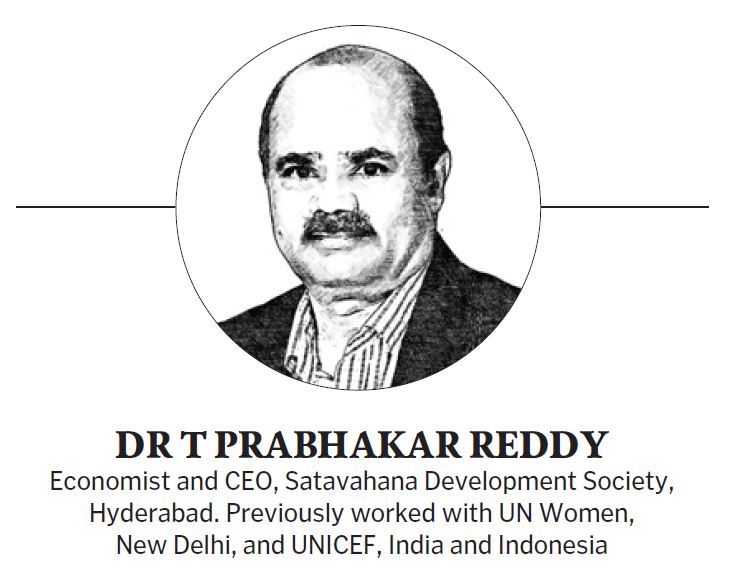NITI Aayog, being a nodal agency for SDGs, should have given orientation to all the States and UTs uniformly to localise the SDGs
Published Date – 11:59 PM, Thu – 28 September 23

By Dr T Prabhakar Reddy
On September 25, 2015, UN member states committed to Sustainable Development Goals (SDGs) and adopted to achieve extraordinary things in the next 15 years. The SDGs are intended to galvanise action worldwide through concrete targets for the period 2015-30 for poverty reduction, food security, human health and education, climate change mitigation and a range of other objectives across the economic, social and environmental pillars.
In fact, SDGs are truly universal development agendas distinctly different from their predecessors Millennium Development Goals. It is much more ‘comprehensive’ and integrates the economic, social and environmental dimensions of sustainable development into its goals and addresses the systemic barriers. It is a universal agenda that applies to all countries, regions, rich and poor, acknowledging the development which is much more than the eradication of extreme poverty. Universality not only means solidarity between countries but also represents a ‘shared responsibility’ and action by all. As a result, the 2030 agenda shifts the policy space for global development from development cooperation alone to essentially all policy areas at national and international levels.
The Strategy
Many States are lagging behind in the implementation of SDGs in their true spirit. Hence, it is time we got it translated into action for which localising SDGs is the need of the hour. While doing so, firstly there is a need to prepare ‘vision documents and action plans’ at State and district levels. These must reflect the commitment and alignment of States’ goals with SDGs.
Secondly, implementation and coordination structures must be constituted at State, district and sub-district levels as the actual implementation takes place at the grassroots level. For this, we should identify nodal officers at all levels from each department, and sensitise and motivate them with the necessary knowledge and techniques to work towards the realisation of SDGs.
Thirdly, development programmes related to SDGs implemented by the State governments must mention the targets with timelines etc. Fourthly, identify or define the State-specific indicators for monitoring the progress of SDGs and enable NITI Aayog to obtain a bigger picture of achievements (NITI Aayog, 2022).
Fifthly, plan, prepare and procure capacity-building resources and training tools at State, district and sub-district levels so as to enhance the necessary skills and techniques. Sixthly, align State budgets with SDGs and prepare them with the involvement of local people, gram panchayats as they are local self-governing institutions, and other stakeholders.
Despite the determined efforts of the government, the States are suffering from challenges in the implementation. These include data gaps, coordination between different agencies, convergence of stakeholders, documentation of the work done and institutional arrangements. Hence, localising SDGs would reflect the grassroots level realities which are essential for bringing about a change from the bottom. Decentralised planning (and governance) and execution of programmes at the village level are the crux of the matter. For this, involving all stakeholders, in a convergent approach, who could influence decision-making is critical.
A fundamental transformation towards an integrated approach to SDG implementation is thus required on a priority basis. This calls for close coordination of policy efforts and responsibilities between various departments and local authorities. Agenda 2030 provides an opportunity for making different policies more coherent in a way that considers the impact of actions and targets along both sectoral and national dimensions with policies reflecting a profound understanding of the various interlinking relationships.
Status of Implementation
The implementation of SDGs in States represents a different focus, bits and pieces approach. While Andhra Pradesh has formulated a vision for each district helping the local self-governing institutions to implement the strategies adopted in Vision 2029, Assam has designed an SDGs manual for districts and councils to prepare a vision for 15 years so as to help integrate SDGs in their planning tools.
Arunachal Pradesh has been striving to integrate SDGs into Gram Panchayat Development Plans (GPDPs) and develop the capacities of PRIs on SDGs. Chhattisgarh has set up ‘Panchayat Development Goals’ as part of GPDPs whereas Haryana is coming up with SDG-based GPDP that will be prepared by panchayats.
Jammu & Kashmir has formed district and block-level committees to coordinate the implementation at the panchayat level and monitoring units in selected urban areas. Karnataka is focusing on capacity building of officials and elected representatives of PRIs for localising SDGs while Kerala has set up Centre for SDGs and Local Government to mainstream SDGs into the local plans.
Madhya Pradesh is in the process of disaggregating the actionable points at district and GP levels while Maharashtra has introduced statutory interventions for implementation targets by the district administration and district planning committees (DPCs) to assign funds for the programmes. Mizoram has conducted a baseline survey at the local level to prepare a ‘Village Development Plan’ for selected villages to implement SDGs at the village level.
In Punjab, the Department of Rural Development and Panchayats and local government have involved PRIs and urban local bodies (ULBs) to achieve the targets fixed under SDGs at the grassroots level. Rajasthan has taken up sensitisation and implementation at the PRI level for the integration of SDGs with GPDP. Tamil Nadu has created ‘Village Poverty Reduction Committees’. Telangana tried to identify village-level priorities and resources available for the preparation of GPDPs while Tripura has conducted an orientation programme for resource persons on aligning local plans with the SDGs.
Uttar Pradesh constituted a task force led by the Chief Secretary and advised PRIs and ULBs to integrate SDGs into their GPDPs. Similarly, Uttarakhand identified a pool of master trainers and trained PRI functionaries for the alignment of GPDP with SDGs. As regards the NCT of Delhi, the municipal corporations are implementing a number of schemes in education, health, urban development, water supply and sanitation, clean water and air and greening public spaces.
The Way Forward
These show a lack of consensus on how to implement the SDGs by localising them with a proper strategy. In fact, NITI Aayog, being a nodal agency for SDGs, should have given orientation to all the States and UTs uniformly to localise the SDGs and adhere to timelines. In the absence of it, each State has its own methodology while lacking an understanding of the implementation and monitoring the progress. Even after eight years, some States are still unable to identify the relevant departments and nodal officers, conduct sensitisation or capacity-building programmes.
However, international agencies like the UNICEF and the UNDP are extending technical support by recruiting experts and economists and creating SDG cells in some States, enabling them to align the State budgets with that of SDGs which are getting translated into GPDPs. More importantly, people’s participation is missing at the local level while NGOs and civil society organisations are yet to play a vital role. Further, building policy frameworks that explicitly recognise panchayats as a central force in coordinating local responses to SDGs’ implementation is essential. Citizen engagement in planning processes is crucial too.
It is high time NITI Aayog created an implementation structure and extended support —technically and financially — to all the States and UTs to localise SDGs, besides monitoring the progress regularly to obtain a bigger picture.






